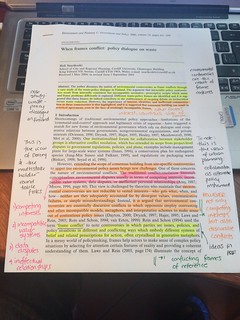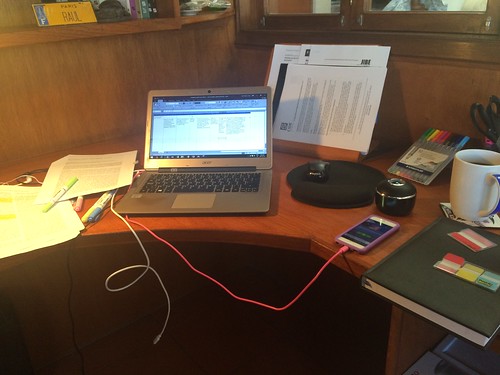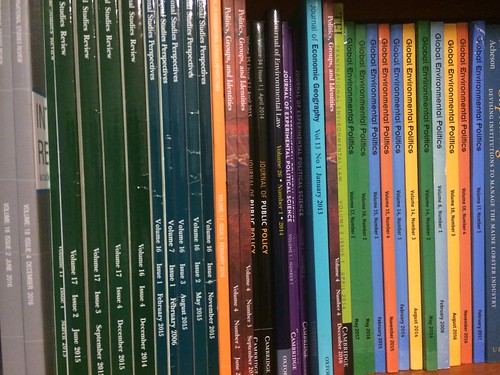Earlier today I was asked about whether my memorandums play a role in how I approach my research, and what my overall strategy is.
you seem to have a pretty precise strategy, but is it summarised somewhere? what role does memos play in the overall etc?
— Nicolai B. Hansen (@nbhansen) July 25, 2017
I woke up a little bit earlier than usual and figured I could answer this question in a quick blog post. While getting a shower, I reflected on what exactly would I call (if it were to call it in any way) my approach to research. I guess the best description of my research strategy is that I use a full-engagement-based approach.
For me, conducting research implicitly means generating new data, analyzing old data in new ways, theorizing and producing new knowledge. I would assume this is the way in which other researchers work. HOWEVER, for me, the generative component of research is always there. Without engaging in actor-network theory, I enjoy the physicality of research output generation. I scribble notes on the margins of papers. I highlight with different colours. I learn better when there’s a physical component to how I do research, how I study. I write synthetic notes and full-fledged memorandums, I fill rows in my Conceptual Synthesis Excel Dump. Every time I do something research-related, there’s a very physical component to it. I need to PRODUCE something as I interact with a piece of scholarship. That’s why the process I use to write papers has so many “productive” components.
Here's a good example of "habit of mind' from @raulpacheco, "whatever I read eventually will end up on one (or more) of my papers." #AcWri https://t.co/nMmMvt2OKV
— Nick Carbone (@ncarbone) July 25, 2017
 That’s why I read deeply and fully engaged. While I also skim articles, books and book chapters, and I’ve suggested that students and academics should use the AIC Content Extraction method to undertake quick overviews of a body of literature, my reading is usually fully engaged, and as a result, I do it in a way that is methodical and generates something that makes me learn (that’s why my marginalia usually include comments on other bodies of literature and linkages across scholarly fields). That’s precisely why the vast majority of my reading is deeply engaged. I usually write on the margins, highlight and THEN dump my notes into either a row of my Conceptual Synthesis Excel dump, or in my Everything Notebook, or even more importantly, I write a synthetic note or a full-fledged memorandum.
That’s why I read deeply and fully engaged. While I also skim articles, books and book chapters, and I’ve suggested that students and academics should use the AIC Content Extraction method to undertake quick overviews of a body of literature, my reading is usually fully engaged, and as a result, I do it in a way that is methodical and generates something that makes me learn (that’s why my marginalia usually include comments on other bodies of literature and linkages across scholarly fields). That’s precisely why the vast majority of my reading is deeply engaged. I usually write on the margins, highlight and THEN dump my notes into either a row of my Conceptual Synthesis Excel dump, or in my Everything Notebook, or even more importantly, I write a synthetic note or a full-fledged memorandum.
In the case I show in the photo above, it’s clear that if I generated so many notes about the text, it’s an important (key) piece of scholarship and I should engage with it by writing a memorandum. Obviously, I know that the text from this memorandum may end up in one of my papers.
i would be humbled and honored if any one read my work as closely as you seem to read EVERYTHING
— Sara Goodman (@ThatSaraGoodman) July 25, 2017
That’s also why, despite my interest in using productivity software and online tools to make my work better, and despite the fact that I store PDFs on Dropbox and upload them on to Mendeley for easy access and quick paper writing, I still read paper-based journals. I still subscribe and pay for the actual physical copy. There’s a feeling I can’t quite describe associated with reading paper-based materials.
But as I was pondering how the memorandums fit within my own strategy, I figured I didn’t want to call this “a physicality-based approach to research”. Because much as I like the physical aspect of creating research materials, like a memo, writing the memorandum is part of fully engaging with the research. Writing synthetic notes and memorandums out of a synthetic note, rhetorical precis, creating annotated bibliographies, analyzing data and typing the analysis into a memorandum, all are part of this full engagement with the research process.



0 Responses
Stay in touch with the conversation, subscribe to the RSS feed for comments on this post.